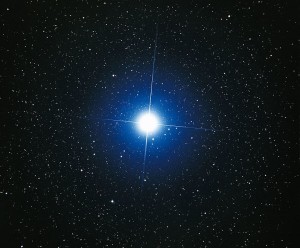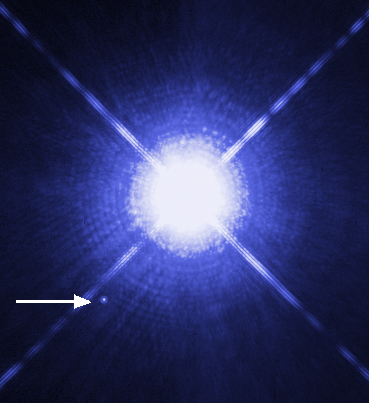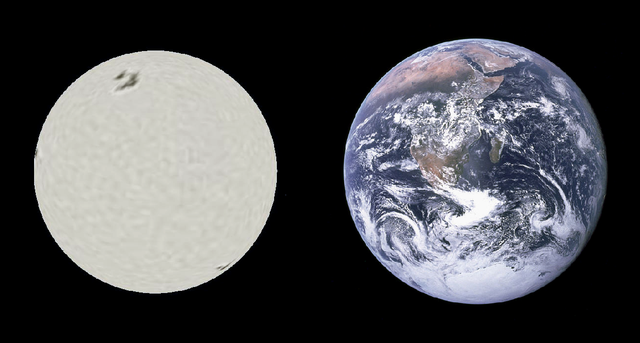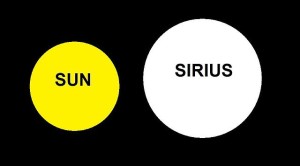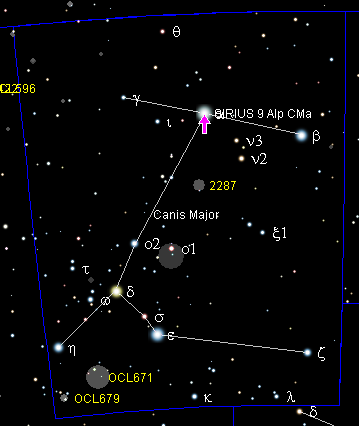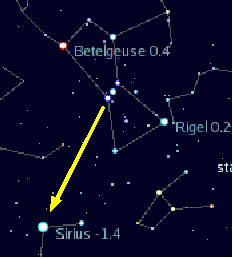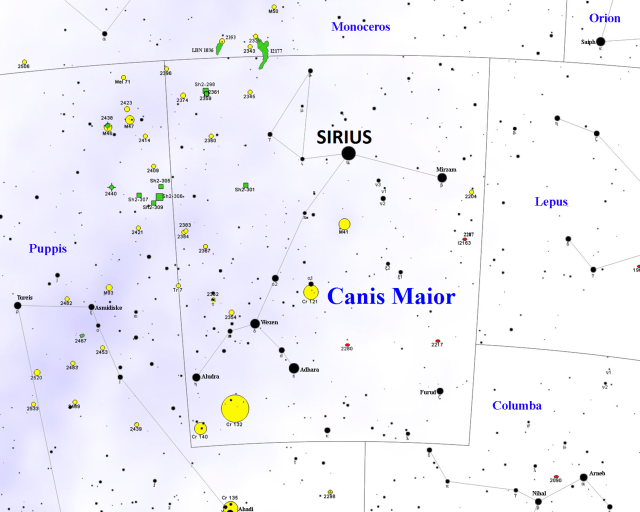Sirius, also known as the Dog Star, α Canis Majoris (Alpha Canis Majoris), or Canicula, is the brightest star in the night sky. It lies at a distance of 8.60 light years (2.64 parsecs) from Earth, in the constellation Canis Major, the Greater Dog. Sirius is not the brightest star because it is more luminous than other visible stars, but because it is located so close to the solar system. It is the fifth closest star system to Earth and contains two of the eight nearest stars to Earth.
Sirius is slowly moving closer to Earth and will gradually increase in brightness over the next 60,000 years, before it starts to recede. It will, however, remain the brightest star seen from Earth for the next 210,000 years.
Sirius has an apparent magnitude of -1.46, which makes it almost twice as bright as Canopus, the second brightest star in the sky, located in Carina constellation.
It is, however, significantly less luminous than Canopus, Rigel, and many other bright stars that lie at greater distances.
The name Sirius (pronounced /ˈsɪriəs/) comes from the Latin Sīrius, which is derived from the Greek Σείριος (Seirios), meaning “scorcher” or “glowing.” The star’s other name, the Dog Star, has similar connotations.
In ancient times, the Dog Star’s heliacal rising marked the flooding of the Nile in Egypt, while the Greeks associated it with the “dog days” of summer, referring to the period from July 3 to August 11, when the star rises in conjunction with the Sun.
The heliacal rising is the first rising of a star (or a planet, a constellation, or the Moon) over the eastern horizon just before sunrise after a period when the star had not been visible. Every day after the heliacal rising, the star rises a bit earlier and is visible for a little longer before dawn.
Star system
Alpha Canis Majoris appears as a single star to the unaided eye, but it is really a binary star system, composed of a white main sequence star belonging to the spectral class A1 V, known as Sirius A or Alpha Canis Majoris A, and a dim white dwarf with the stellar classification DA2, designated Sirius B or Alpha Canis Majoris B.
The two white stars orbit each other with a period of 50.1 years and an average separation roughly 20 times the distance from the Earth to the Sun.
The distance between the two stars in the binary system varies from 8.2 to 31.5 astronomical units. The angular separation between them varies from 3 to 11 seconds of arc.
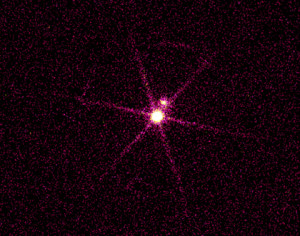
An X-ray image of the Sirius star system located 8.6 light years from Earth. This image shows two sources and a spike-like pattern due to the support structure for the transmission grating. The bright source is Sirius B, a white dwarf star that has a surface temperature of about 25,000 degrees Celsius which produces very low energy X-rays. The dim source at the position of Sirius A – a normal star more than twice as massive as the Sun – may be due to ultraviolet radiation from Sirius A leaking through the filter on the detector. In contrast, Sirius A is the brightest star in the northern sky when viewed with an optical telescope, while Sirius B is 10,000 times dimmer. Because the two stars are so close together Sirius B escaped detection until 1862 when Alvan Clark discovered it while testing one of the best optical telescopes in the world at that time. Image: NASA/SAO/CXC
At the closest approach every 50 years, Sirius A and Sirius B can only be resolved with a 12-inch telescope in good viewing conditions. As the two stars approach each other, huge magnetic storms are created between them and both stars start to spin faster as a result of tidal forces getting stronger.
The primary component, Sirius A, is roughly twice as massive as the Sun and 25 times more luminous. It has an estimated surface temperature of 9,940 K.
Sirius B is 10,000 times less luminous, but a brighter X-ray source of the two. It orbits around the primary component in a wide horizontal ellipse when observed from Earth. The star has an estimated surface temperature of 25,200 K. It is the nearest known white dwarf.
Sirius A is classified as an Am star because studies of the star’s spectrum have revealed deep metallic absorption lines, suggesting a significant presence of elements heavier than helium, like iron. The star has 316% of the proportion of iron found in the atmosphere of our Sun.
The estimated age of the system is between 200 and 300 million years. The Sirius system originally consisted of two bright blue stars. Alpha Canis Majoris B was the more massive one, with roughly 5 solar masses, but then it consumed its resources and evolved into a red giant before expelling its outer shell and becoming a white dwarf some 120 million years ago.
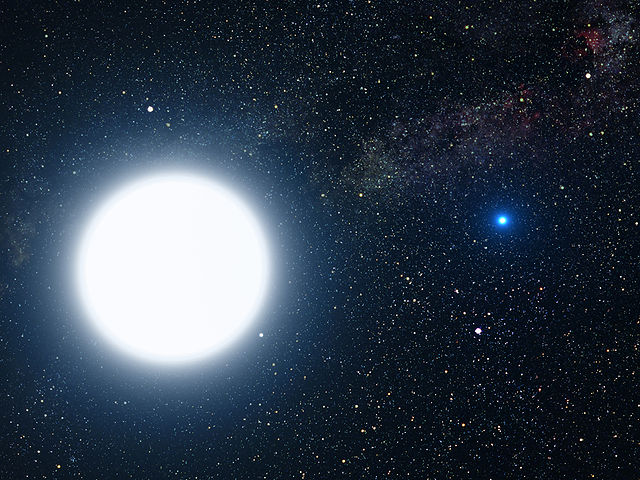
This picture is an artist’s impression showing how the binary star system of Sirius A and its diminutive blue companion, Sirius B, might appear to an interstellar visitor. The large, bluish-white star Sirius A dominates the scene, while Sirius B is the small but very hot and blue white-dwarf star on the right. The two stars revolve around each other every 50 years. White dwarfs are the leftover remnants of stars similar to our Sun. The Sirius system, only 8.6 light-years from Earth, is the fifth closest stellar system known. Sirius B is faint because of its tiny size. Its diameter is only 7,500 miles (about 12 thousand kilometres), slightly smaller than the size of our Earth. The Sirius system is so close to Earth that most of the familiar constellations would have nearly the same appearance as in our own sky. In this rendition, we see in the background the three bright stars that make up the Summer Triangle: Altair, Deneb, and Vega. Altair is the white dot above Sirius A; Deneb is the dot to the upper right; and Vega lies below Sirius B. But there is one unfamiliar addition to the constellations: our own Sun is the second-magnitude star, shown as a small dot just below and to the right of Sirius A. Image: NASA, ESA. Credit: G. Bacon (STScI)
Sirius B has a mass almost equal to the Sun, 0.98 solar masses, which makes it one of the more massive white dwarfs known. However, the star’s mass is concentrated into a volume comparable to that of the Earth. Sirius B has a almost the diameter of our planet, 12,000 kilometres, or 7,500 miles. The star’s diameter was measured in 2005 using the Hubble Space Telescope.
The binary companion was discovered by the German astronomer Friedrich Bessel, who deduced that the star had an unseen companion from the changes in the proper motion of the main component.
The American astronomer Alvan Graham Clark was the first to observe the dim companion on January 31, 1862. He used the largest refracting lens avaiable at the time and spotted the star while testing an 18.5-inch refractor for Dearborn University. The companion, Sirius B, is sometimes referred to by its nickname, the Pup.
The Alpha Canis Majoris system may have a very small third component, but its existence has never been confirmed. If the star does exist, it has a mass of only 0.06 solar masses and completes an orbit around the main component every six years. Its existence is only indicated by some orbital irregularities in the star system.
Walter Sydney Adams was the first to discover that Sirius B was a white star. He used a 60-inch reflector at Mount Wilson Observatory and, while observing the star’s spectrum, he concluded that it was a whitish star. Astronomers later determined that the star was a white dwarf, only the second one to be discovered.
In 2005, data from the Hubble Space Telescope helped astronomers determine that Sirius B has almost the diameter of the Earth, around 12,000 kilometres or 7,500 miles, and a mass 98 percent that of the Sun. This was the first time that astronomers were able to accurately measure the mass of Sirius B.
Facts
The earliest recorded use of the name Sirius dates from the 7th century, when the Greek poet Hesiod mentioned the star in his didactic poem Works and Days.
Sirius has more than 50 names and designations attached to it. In medieval astrolabes from western Europe it is called Alhabor. This is the name Geoffrey Chaucer used in his Treatise on the Astrolabe, with the star depicted as a dog’s head.
In Scandinavian countries, the star has been known as Loki’s torch, or Lokabrenna, which literally means “burning done by Loki.”
The only objects in the sky brighter than Sirius are the Moon, Venus, Jupiter, and occasionally Mercury and Mars.
Sirius was one of the stars that led Edmond Halley to the discovery of proper motion among the so-called “fixed” stars. In 1718, Halley compared contemporary data to the information provided in Ptolemy’s Almagest and found that the bright stars Aldebaran in Taurus, Arcturus in Boötes and Sirius had moved significantly over the period of 1,800 years. Sirius had progressed 30 arc minutes to the south since Ptolemy’s times.
Sirius was the first star to have its velocity measured. In 1868, Sir William Huggins wrongly presumed that the star was receding from the Sun at roughly 40 km/s, but his conclusion is notable for introducing the study of radial velocities of stars. Sirius is really moving toward the solar system at 7.6 km/s.
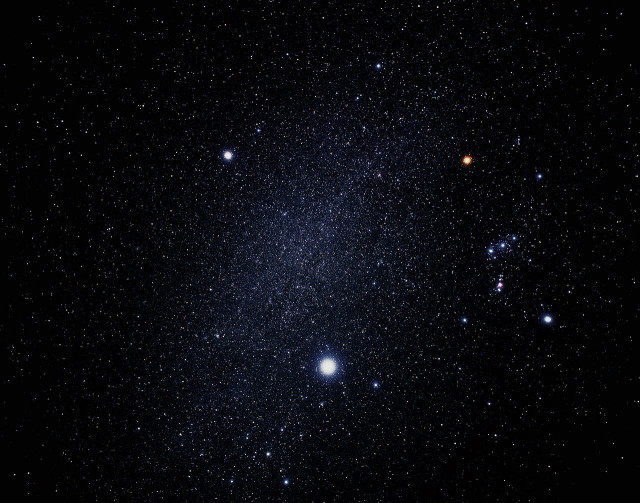
The Winter Triangle: Procyon (top left), Betelgeuse (top right), Sirius (base). Image: Hubble European Space Agency, credit: Akira Fujii
Along with the bright stars Procyon in Canis Minor and Betelgeuse in Orion constellation, Sirius forms the Winter Triangle, a familiar asterism in the night sky, and easy to spot in winter evenings in the northern hemisphere.
Procyon, Alpha Canis Minoris, is the nearest large neighbouring star to Sirius, located 5.24 light years away in the constellation Canis Minor.
The Voyager 2 spacecraft, which was launched in 1977 to study the Jovian planets in our system, will pass within 4.3 light years of Sirius in about 296,000 years – assuming the spacecraft is still around. (One light year is almost 10 trillion kilometres, or 6 trillion miles.)
At one point, Sirius was thought to be a member of the Ursa Major Moving Group, an association of stars including most of the brighest stars in Ursa Major constellation, that share a common origin and proper motion through space. In 1909, Ejnar Hertzsprung was the first to suggest this after observing the star system’s movements across the sky. It wasn’t until 2003 and 2005 that analyses revealed this to be unlikely. The stars in the Ursa Major Moving Group were roughly 500 million years old and Sirius is about half this age, and therefore too young to belong to the association.
Alpha Canis Majoris may instead belong to the Sirius Supercluster, a proposed supercluster that includes the stars Beta Aurigae in Auriga constellation, Alpha Coronae Borealis in Corona Borealis, Beta Crateris in Crater, Beta Eridani in Eridanus, and Beta Serpentis in Serpens.
The diameter of the primary star, Sirius A, was first measured by Robert Hanbury Brown and Richard Q. Twiss at Jodrell Bank in 1959.
The first spectrum of Sirius B was obtained at Mount Wilson Observatory in 1920. The first photograph of the companion was taken by Dr. Irving W. Lendenblad of the U.S. Naval Observatory in 1970.
The colour of Sirius has caused some debate over the centuries, as a number of ancient accounts indicated that the star was red. The Greek astronomer Ptolemy was one of the many who described its appearance as reddish. Around the year 150 AD, he mentioned the star’s reddish colour, including it with five other stars that are all known to be either red or orange: Antares in Scorpius constellation, Arcturus in Boötes, Betelgeuse in Orion, Aldebaran in Taurus, and Pollux in Gemini. Seneca, too, had noted that Sirius was of a deeper red colour than Mars. However, at the same time, there were many observers who described the star as blue or white.
While it is possible that observers could have been describing the star as it appears when it is close to the horizon, with its colour affected by the Earth’s atmosphere, there has not been a single conclusive explanation for the discrepancy ever since the issue of Sirius’ colour first got serious attention at the Royal Society way back in 1760.
Sirius’ flickering and colour changes, which have prompted some observers to report UFO sightings, can be explained by the fact that the star often appears low in the sky in northern latitudes and its light passes through a long column of air in our atmosphere and is affected by changes in the air’s temperature and density before it reaches observers. Sirius is not the only star affected by this phenomenon, but the changes in colour are more noticeable because the star is so bright and often appears near the horizon.
Mythology and culture
In ancient Egypt, Sirius was known as Sopdet (Greek: Σῶθις, or Sothis), the goddess who was part of the triad with her husband Osiris and son Horus. The hieroglyph for Sothis has a star and a triangle.
Egyptians based their calendar on the heliacal rising of Sirius in the era of the Middle Kingdom. The star’s rising marked the beginning of the new year and the event was celebrated with a festival known as “The Coming of Sopdet.”
The day Sirius became visible just before dawn after moving far enough away from the Sun to not be lost in the Sun’s glare signalled the flooding of the Nile every year. This would happen just before the summer solstice and the star would be visible before sunrise after being absent from the skies for about 70 days.
The 70-day absence symbolised Osiris and his wife’s passing through the Egyptian underworld, the Duat. The flooding of the Nile brought fertility to the land when the star appeared, and Egyptians associated the goddess with both the inundation, fertility and the new year. They called Sirius the Nile Star.
The Egyptians believed that Sirius caused the floods and they noted that the star’s heliacal rising occurred every 365.25 days rather than 365 days. The correction in the length of the calendar year was eventually incorporated in the Julian calendar.
The Egyptians also saw Sirius as the doorway to the afterlife and would not bury their passed family members during the 70 days the star was hidden from view – the 35 days before and after Sirius conjuncted the Sun. They believed the doorway was closed when the star was out of view.
Several occult researchers believe that the Great Pyramid of Giza was constructed in perfect alignment with stars, particularly with Sirius and the three stars of the Orion’s Belt. Recent findings related to the pyramid’s mysterious air shafts have strengthened the theory of Sirius’ importance to Egyptians.
The Greeks noticed that the star’s appearance in the sky heralded the hot, dry summer season. Sirius was known to twinkle more in the early summer and the Greeks interpreted this as a malignant influence. The star was often described as “burning” in various texts, and the season it heralded became known as the dog days of summer.
On the island of Ceos, inhabitants would offer sacrifices to Zeus and Sirius to bring cooling breezes and, if Sirius rose clear, they would see this as a sign of good fortune. If the star was faint or misty, it foretold pestilence. Archaeologists found coins on the island dating from the 3rd century BC that featured dogs and stars with emanating rays.
The Romans, similarly, celebrated the star’s heliacal rising around April 25, and would sacrifice a dog and a sheep to the goddess Robigo in the hope that the star would not cause wheat rust on their crops that year. They called the hottest days of the summer dies caniculares and Sirius was known as Canicula, or “little dog.”
The star is associated with dogs in a number of cultures. Being the brightest star in the Greater Dog constellation, it was classically represented as one of the dogs of Orion, the Hunter. Homer calls the star “Orion’s Dog” in The Iliad. In ancient Greece, there was a belief that the star could make dogs behave abnormally during the summer.
The Chinese knew Sirius as the star of the “celestial wolf.” In anicent times, they visualised the constellations Puppis and Canis Major as a large bow and arrow, with the arrow tip pointed at the wolf.
Ancient Polynesians used Sirius for navigation, and saw it as part of the Great Bird constellation called Manu. The bright star Canopus in Carina marked the southern wingtip and Procyon in Canis Minor the northern one. The constellation divided the sky into two hemispheres, and the stars were used as latitude markers. The declination of Sirius matches the latitude of Fiji at 17°S, which means that the star passes directly over the islands every night.
To the Māori, the star marked the beginning of the winter season. They had the same name to describe both the star and the season: Takurua.
In Hawaii, Sirius was known as Ka’ulua, or the Queen of Heaven. The star’s culmination at the winter solstice was celebrated with an event every year.
In India, the star is sometimes known as Svana, the dog of Prince Yudhistira, who set out of a long journey to find the kingdom of heaven with his four brothers. The journey was a difficult one and, one by one, the brothers abandoned the search. When Yudhistira reached the gates of heaven, Lord Indra welcomed him, but would not let Svana enter. The prince told him that he himself would not enter if his faithful servant was denied entrance. This is what the Lord wanted to hear, and he then allowed them both through the gates.
In Sanskrit, the star is known as Mrgavyadha, or “deer hunter,” representing Rudra (Shiva), or as Lubdhaka, meaning “hunter.”
In Persian mythology and Zoroastrianism, Sirius is seen as Tishtrya and revered as the divinity bringing rain and fertility.
Sirius is mentioned in the Qur’an, where it is called the Mighty Star or Leader. The star’s other proper name, Aschere, is derived from Arabic.
Many indigenous peoples of North America associated Sirius with figures of dogs and wolves. The Blackfoot knew the star as “Dog-face,” Pawnee tribes of Nebraska called it the “Wolf Star” or “Coyote Star,” and the Cherokee saw Sirius and Antares in Scorpius constellation as dog-star guardians of the two ends of the Path of Souls. The Alaskan Inuit knew Sirius as “Moon Dog.”
The Dogon people in Mali in West Africa reported to have knowledge about Sirius that would be impossible without using telescopes. Based on information revealed in the French anthropologist Marcel Griaule’s books Conversations with Ogotemmêli and The Pale Fox, the Dogon were familiar with the star’s 50-year orbital period and knew it was a binary star before western astronomers did. They also refer to a second companion, the third star in the system, which accompanies Sirius A and B.
To add to the controversy, Robert Temple’s book The Sirius Mystery, published in 1976, claims that the Dogon knew about the rings of Saturn and the four Galilean moons of Jupiter. Temple speculates that the Dogons, an ancient tribe who have worshipped Sirius for the past 5,000 years, had a direct connection with beings from Sirius.
In a Dogon myth explaining the origin of the human race, humanity was born from the Nommo, a race of amphibians who came to Earth from a planet orbiting Sirius. The Nommo are said to have given humans profound knowledge, including information about Sirius and our own solar system.
Location
Sirius can be seen from any location on Earth south of 73°N. However, from locations that are further to the north, but south of 73°N, the star doesn’t rise very high above the horizon. For observers south of 73°S, Sirius is circumpolar: it never sets below the horizon.
As a result of precession, Alpha Canis Majoris will move further south and, in the year 9,000, it will not be visible from most locations in northern and central Europe. In the year 14,000, when Vega takes over as the pole star, Sirius will be found at declination -67° and never set below the horizon for observers in South Africa and in most parts of Australia.
The easiest way to locate Sirius in the night sky is by using the stars of the Orion’s Belt as pointers. The three bright belt stars – Alnilam, Alnitak, and Mintaka, point downward to Sirius to the left. Sirius is about 8 times as far from the Orion’s Belt as the belt is wide.
For most observers in northern latitudes, Sirius lies in the southeast, south, or southwest sky in the evenings from winter to mid-spring. The star can also be seen rising in the east before dawn in the late summer.
Sirius – Alpha Canis Majoris
Constellation: Canis Major
Coordinates: 06h 45m 08.9173s (right ascension), -16°42’58.017” (declination)
Distance: 8.60 ± 0.04 light years (2.64 ± 0.01 parsecs)
Orbital period: 50.090 ± 0.055 years
Designations: Sirius, Dog Star, α Canis Majoris (α CMa), 9 Canis Majoris (9 CMa), Canicula, Al Shira, Sothis, Alhabor, Mrgavyadha, Lubdhaka, Tenrōsei, HD 48915, HR 2491, BD −16°1591, GCTP 1577.00 A/B, GJ 244 A/B, LHS 219, ADS 5423, LTT 2638, HIP 32349, B: EGGR 49, WD 0642-166
Sirius A
Spectral class: A1V
Visual magnitude: -1.47
Absolute magnitude: 1.42
Mass: 2.02 solar masses
Radius: 1.711 solar radii
Luminosity: 25.4 solar luminosities
Temperature: 9,940 K
Age: 2-3 million years
Sirius B
Spectral class: DA2
Visual magnitude: 8.30
Absolute magnitude: 11.18
Mass: 0.978 solar masses
Radius: 0.0084 solar radii
Luminosity: 0.026 solar luminosities
Temperature: 25,200 K
